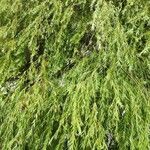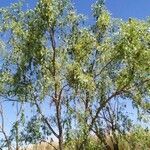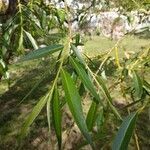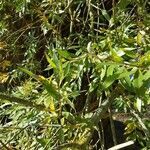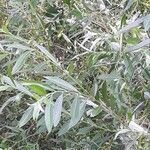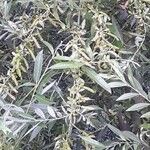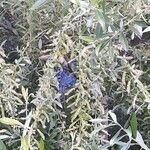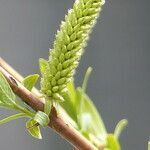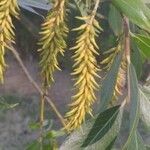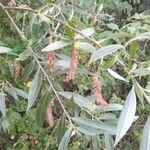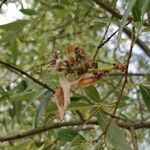Trees to 20(-25) m tall; trunk to 1 m d.b.h.; bark dull gray, fissured; crown spreading. Branchlets brownish, glabrous, tomentose when young. Buds coadnate, ca. 6 × 1.5 mm, apex acute. Stipules caducous; petiole 2-10 mm, sericeous; leaf blade lanceolate, oblanceolate, or obovate-lanceolate, 5-12 (-1.5) × 1-2(-3.5) cm, abaxially tomentose or subglabrous, adaxially often glabrous, both surfaces sericeous when young, base cuneate, margin serrulate, apex acuminate or long acuminate; lateral veins 12-15 on each side of midvein. Flowering coetaneous. Male catkin 3-5 cm; peduncle 5-8 mm; bracts yellowish, ovate-lanceolate or obovate-oblong, ciliate, abaxially glabrous, adaxially subglabrous or pilose at base, margin entire. Male flower: glands adaxial and abaxial; stamens 2, free; filaments pilose at base; anthers yellow. Female catkin 3-4.5 cm, to 5.5 cm in fruit; bracts yellowish, lanceolate or ovate-lanceolate, ciliate, caducous, abaxially cottony at base, adaxially sericeous. Female flower: glands adaxial and abaxial, adaxial gland rarely small; ovary ovoid-conical, 4.5-5 mm, glabrous, shortly stipitate or subsessile; style short, 2-lobed; stigma 2-parted. Fl. Apr-May, fr. May. 2n = 76.
Tree to c. 25 m high, but usually much < 15 m; bark dark greyish, fissured. Branchlets and shoots spreading to erect, usually yellow or orange-yellow, sometimes olive, greenish brown or red, tough and flexible, not snapping, soon glabrous. Buds glabrous and brown, or whitish hairy. Petiole of lvs on reproductive branches usually < 1 cm long. Lamina 4-13 × 1-2-(2.7) cm, lanceolate, ± shining and usually soon becoming glabrous on upper surface, glaucous and usually eventually glabrous on lower surface, sometimes persistently silky hairy on both surfaces, glandular-serrulate, sparsely to densely ciliate; apex acute or short-acuminate. Stipules minute. Catkins ♂ or ♀, appearing with lvs, narrow-cylindric. ♂ catkins to 4 cm long, spreading and often tending to curve downwards; rachis villous. Bracts 2-4 mm long, ovate-elliptic, elliptic-oblong or ± oblong, pale green, hairy; margins strongly incurved; apex obtuse or acute. Glands 2, the larger anterior one 0.4-0.5 mm long, oblong to square. Stamens 2; filaments hairy towards base. ♀ catkins similar to ♂; gland 1 (anterior), 0.4-0.5 mm long, broader than long to semi-annular. Ovary sessile, glabrous.
Tree rarely exceeding l2 m in Australia; crown spreading, trunk often branching close to ground; main branches erect; smaller branches often shortly pendulous; bark grey, fissured; twigs glabrescent, shiny yellow-to red-brown. Leaves narrowly elliptic or oblanceolate, often slightly asymmetric, apex acute or acuminate, 30-80 mm long, 6–18 mm wide, very finely but sharply toothed with a small gland in sinus in front of each tooth; base cuneate; upper surface green, glabrescent, clearly pinnately-veined; lower surface pale green or glaucous, sparsely to densely covered with silky appressed hairs or glabrescent; venation obscure; petiole 2–4 mm long; stipules small, caducous. Catkins appearing with leaves in spring, pedunculate, terminating short lateral branches with reduced leaves; floral bracts elliptic, obtuse or acute, the base and margin densely hirsute. Male catkins 30–90 mm long, 5–11 mm diam.; stamens 2; filaments hirsute at base; nectaries 2, the adaxial one more prominent. Female catkins 30–60 mm long, longer in fruit, 5–7 mm diam. Fruits sessile, conical, glabrous, abruptly narrowed at apex, the stigma subsessile.
Tree to 25 m; twigs spreading or sometimes pendulous, greenish to yellowish, long-sericeous, somewhat brittle at base; stipules minute and caducous; lvs narrowly lanceolate to lanceolate, 4–10(–15) × 1–2.5 cm, acuminate, with 7–10 glandular teeth per cm of margin, glaucous beneath, ± silvery-silky on both sides but especially beneath; petioles sericeous, 3–6 mm, those on vigorous young shoots glandular at the tip; catkins with the lvs, 3–6 cm, on peduncles 1–4 cm with 2–4 small lvs; scales as in no. 8 [Salix fragilis L.]; stamens mostly 2; fr ovoid-conic, 3–5 mm, glabrous, sessile or subsessile; style 0.2–0.4 mm; 2n=76. Native of Europe, sparingly escaped from cult. in our range. (S. a. var. vitellina, golden w., a long-established cultivar with bright yellow twigs) Hybridizes freely with nos. 8 and 9 [Salix babylonica L.]
A shapely deciduous tree. It often has 1-4 trunks and an open crown of spreading branches. It grows up to 20-25 m tall and 9-12 m wide. The leaves are silvery but blue-green and silky underneath. They are alternate and on short stalks. The leaves are 5-7 times as long as wide. The leaves have fine teeth. The male flowers are yellow catkins. The female flowers are green catkins. The seeds are fluffy. They are blown by the wind.

